Aichi Prefecture is blessed with the sea, mountains, and natural environment, and is rich in ingredients.
In addition to the standard menu that has become popular as Nagoya Meshi, there are many other local gourmet dishes that are popular all over the country!

Higashi Mikawa
Tororo rice from under Curry Udon Noodles!
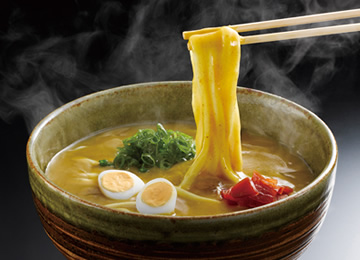

The contents look like this
There is a rule to eat from top to bottom, so be careful how you allocate the curry roux!
Toyohashi
Toyohashi Curry Udon Noodles
Toyohashi is a town of udon culture. There are many udon restaurants, and the percentage of homemade noodles is high. In order to widely appeal as a soul food for citizens, we made many prototypes and debuted in the spring of 2010. Currently, more than 40 stores sell it. Each store is creative, so it's fun to eat around.
Menu features
The basic idea is to use homemade noodles. Curry Udon Noodles have an amazing two-layered structure where the yam rice appears from the bottom. The use of quail eggs from Toyohashi, Fukujinzuke or Tsubozuke, and pickled ginger are also required. Above all, "making with love" is an essential condition.
Clams-flavored udon filled with the blessings of Mikawa Bay
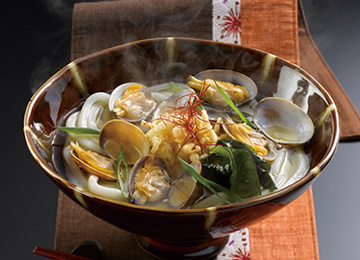
Gamagori
Gamagori udon
Udon noodles were born from the large amount of clams generously donated by fishermen during a movie shoot at Nishiura Fishing Port in the middle of winter. It won the Grand Prix at the National Local Udon Summit the following year. The number of certified stores is approximately 30 in the city, and the number is increasing one after another.
Menu features
At least 5 clams with shells on. The soup is soy sauce flavored. There are five definitions, including wakame and one ingredient from Gamagori (sesame oil, paste, nigisu, mejikari, wakame, etc.)
Toyokawa's B-class gourmet food following Inarizushi
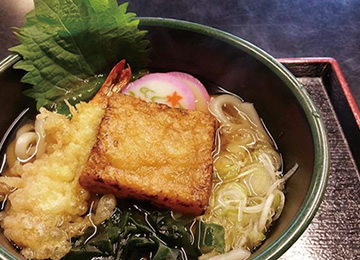
Toyokawa
Toyokawa Inari Udon
Continuing with Toyokawa Inarizushi! was born in 2010. Inari mochi, the star of the dish, is sweet, salty, and fragrant, with a unique texture that will make you addicted to it. It is similar to kitsune udon and chikara udon, but it has its own charm that is different from either. It is currently available at four stores in the city.
Menu features
Inarimochi is made by wrapping a mochi in fried tofu and frying it once before baking it again. The basic idea is to bring out the aroma, but each store has their own ideas. There are three types of soup: tsuyu, curry, and ankake.
Volume bowl unique to Atsumi, a treasure trove of shellfish
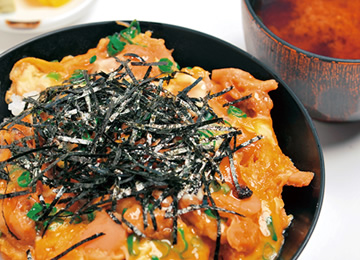
Tahara
Large clam bowl
Tahara City ranked No. 2006 in Japan in agricultural output in 1. In addition, it is surrounded by the sea on three sides, making it a treasure trove of seafood. Taking advantage of this strength, 41 stores are participating in the Atsumi Peninsula Donburi Kaido. While each restaurant competes with its uniqueness using a variety of ingredients, the large clam bowl is a typical dish with a rich local flavor.
Menu features
Approximately 1/4 of the restaurants on Atsumi Peninsula Donburi Kaido serve rice bowls made with locally sourced large clams. Each restaurant uses a variety of cooking methods to bring out the best in the ingredients, including fried, tempura, and kabayaki.
White soy sauce is the key to elegant Japanese-style yakisoba
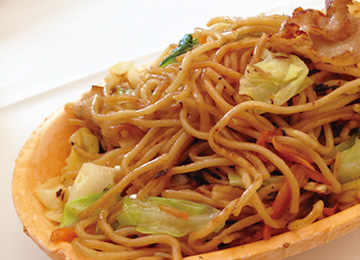
Hekinan City
Hekinan Yakisoba
Local yakisoba made with white soy sauce, a local seasoning that originated in Hekinan and is mainly produced in Nishi Mikawa. Debuted in 2010. The activity started with a team of volunteers displaying the food at an event, and it is currently available at about 15 stores in the city.
Menu features
The base seasoning is white soy sauce, and the ingredients include Ebi senbei, which is also said to have originated in Hekinan, as well as carrots and onions, which are the most produced in the prefecture. It is characterized by an elegant and mellow taste.
Nishi Mikawa
Genuine local food born from local industry
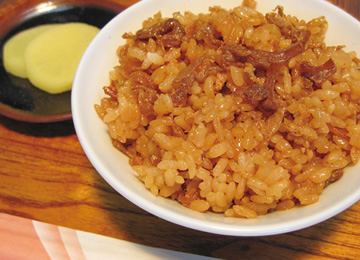
Takahama
Takahama chicken rice
This is an old local food that was born when poultry farming was a local industry, and the custom of eating abandoned chickens that no longer produced eggs became widespread. The Takahama Torimeshi Society was established in 2010, and the products are now exhibited at events. Currently, it is available at over 17 stores in the city.
Menu features
Season the thinly sliced chicken with soy sauce and sugar and mix it with the rice. Because it uses waste chicken, it has a different texture than young chicken. The ingredients are deep-fried. In some areas, carrots are mixed in.
Chita
High-quality ingredients are also available at reasonable prices. Unique cooking methods
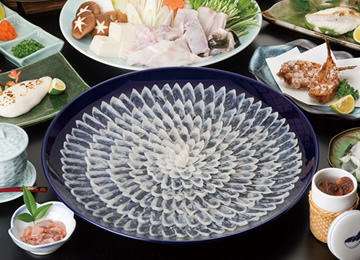
Minamichita Town
Puffer fish
Aichi Prefecture is a good fishing ground for blowfish. Previously, most of the catch was sent to Shimonoseki and other areas, but since around 2000 there has been a growing trend towards local production and local consumption, and local inns and restaurants have learned cooking techniques and are now offering them to customers. In Minamichita in particular, there are nearly 150 longline fishing boats for blowfish.
Menu features
A dish unique to Minamichita is grilled anchovies with fish sauce from Toyohama Port. When grilled slowly over charcoal, it gives off a unique aroma and a fluffy texture that is exquisite.

